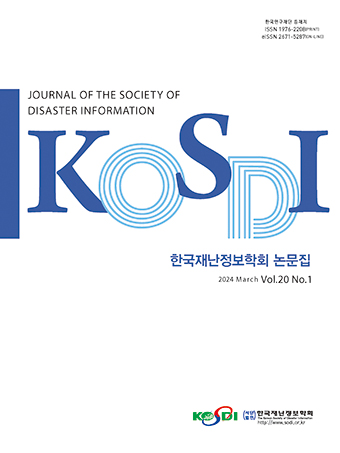Original Article
Abstract
References
Information
Purpose: It is expected that various infrastructures diagnosis equipment will be needed as infrastructures management is strengthened to implement the Framework Act on Sustainable Infrastructure Management. It is necessary for a certification system to supply certified products of a reasonable level in accordance with market requirements for various convergence equipment. This paper deals with the introduction of certification system of inspection and diagnosis equipment for infrastructure using advanced technologies. Method: The basic elements, systems and procedures of certification system were reviewed through analyzing and comparing the existing similar certification system in Korea. In addition, a survey was conducted on a catalog method and the minimum performance criterion (sampling survey and complete enumeration survey) to equipment developers (manufacturers), clients and equipment users. Result: This survey showed that clients preferred complete enumeration method on the basis of minimum performance, and equipment users also preferred complete enumeration survey and sample survey, for minimum performance, at a similar rate. On the other hand, equipment developers preferred the catalog method. Conclusion: Clients and users who are the users of the diagnostic equipment preferred the minimum performance criterion because their trust in quality is important. On the other hand, developers(manufacturers) preferred the catalog method which adopts self certification because it is regulated in developing various products. There is no specific plan for the minimum performance standards required for the introduction of the method which users demand, at present. In addition, it is not desirable to force to introduce a certification system because it requires a considerable period of study to prepare the specific standards. Therefore, it is appropriate to operate the system for a certain period of time centering around the catalog method for the stable and continuous development of the infrastructure diagnosis and test equipment market in Korea. Also, it is effective to expand and develop the certification system to the extent that it minimizes the impact on the market when specific plans for the standards are prepared in the future.
연구목적: 지속가능한 기반시설 관리 기본법 시행으로 시설물관리가 강화되면서 다양한 시설물 진단장비가 필요할 것으로 예상되고 있다. 다양한 융합장비에 대한 시장요구에 맞춰 합리적인 수준의 인증제품 공급하기 위한 인증제도가 필요하다. 본 논문에서는 첨단 기술을 이용한 시설물 진단장비에 대한 인증체계 도입방안에 대하여 연구하였다. 연구방법: 기존 국내 유사인증제도에 대한 상세분석 및 비교를 통하여 인증제도의 기본적인 요소와 체계 및 절차에 대하여 검토하였다. 또한, 카탈로그방식, 최소성능기준(표본조사, 전수조사)에 대하여 진단장비 개발자(제조자), 발주자, 장비사용자를 대상으로 설문조사를 실시하였다. 연구결과: 설문결과 발주자는 최소성능기준 전수조사 방식을 선호하였으며, 장비사용자 역시 최소성능 전수조사 방식과 표본조사를 거의 비슷한 비율로 선호하였다. 반면, 장비개발자는 카탈로그방식을 선호하였다. 결론: 진단장비의 사용자 입장인 발주자와 사용자는 품질에 대한 신뢰가 중요하므로 최소성능기준제시를 선호하였다. 반면, 개발자(제조자)는 다양한 제품의 개발에 규제가 되므로 자기인증방식인 카탈로그방식을 선호하였다. 현재 사용자가 요구하는 최소성능기준 방식의 도입에 필요한 최소성능기준에 대한 구체적 방안이 마련되지 않은 상황이다. 또한 구체적인 최소성능기준 마련에도 상당한 기간의 연구가 필요하므로 무리하게 인증 제도를 도입하는 것은 바람직하지 않다. 따라서 현실적으로 국내 시설물진단 및 검정장비 시장의 안정적이고 지속적인 발전을 위해서는 카탈로그 방식을 중심으로 일정기간 제도를 운영하는 것이 적절하다. 또한, 향후 필요에 따라서 최소성능기준에 대한 구체적 방안이 마련되면 시장에 대한 영향을 최소화 하는 범위에서 인증 제도를 확대 및 발전시켜 나가는 것이 효과적이다.
- Cho, J.Y. (2018). Analysis of Japanese Construction Production System and Implication. RICON.
- Hong, S.H., Kim, J.G., Cho, J.Y., Kim, T.H. (2020). "A study on the necessity of verification and certification system of inspection and diagnostic equipment for infrastructure using advanced technologies." Journal of the Society of Disaster Information, Vol. 16, No. 1, pp. 163-177.
- Kim, J.G. (2020). Investigation of Safety Certification System in Korea. KOSHA Report.
- Korean Standard and Certification, https://standard.go.kr/KSCI/portalindex.do
- Lee, Y.H., Bae, S.J., Jung, W., Cho, J.Y., Hong, S.H., Nam, W.S., Kim, Y.M. (2020). "Performance evaluation method for facility inspection and diagnostic technologies." Journal of the Society of Disaster Information, Vol. 16, No. 1, pp. 178-191.
- Mizutani, T. (2019). "Automatic big data construction of road surface and underground information by camera, laser and radar data analysis." Seisan Kenkyu, Vol. 71, No. 4, pp. 859-863.
- MOLIT (2019). Public hearing material : Sustainable infrastructure management, 2019.12.
- NEDO, https://www.nedo.go.jp/
- Nitta, K. (2016). "Promotion of introducing japanese advanced technologies for social infrastructures management by the japanese government: ICT and next generation robots." Journal of The Society of Instrument and Control Engineers, Vol. 55, No. 6, pp. 470-476.
- Ohta, K. (2020). "Policy responses to deterioration of transportation infrastructure: Focusing on road facilities." IATSS Review, Vol. 44, No. 3, pp. 160-169.
- Yamashita, J., Kimura S., Kawamura, H. (2019). "Maintenance management of transportation infrastructure utilizing 3D point cloud." Journal of the Japan Society for Precision Engineering, Vol. 85 No. 3, pp. 228-231. 10.2493/jjspe.85.228
- Publisher :The Korean Society of Disaster Information
- Publisher(Ko) :한국재난정보학회
- Journal Title :Journal of the Society of Disaster Information
- Journal Title(Ko) :한국재난정보학회논문집
- Volume : 17
- No :1
- Pages :97-111
- DOI :https://doi.org/10.15683/kosdi.2021.3.31.097




 Journal of the Society of Disaster Information
Journal of the Society of Disaster Information







